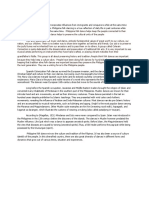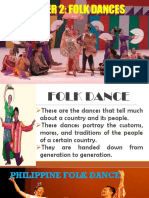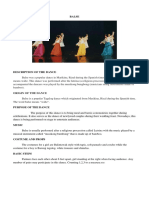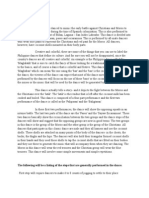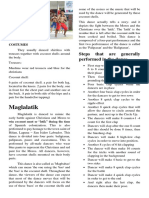Professional Documents
Culture Documents
Definition and History of Mazurka Boholana
Definition and History of Mazurka Boholana
Uploaded by
Maria Christine ManlimosOriginal Description:
Copyright
Available Formats
Share this document
Did you find this document useful?
Is this content inappropriate?
Report this DocumentCopyright:
Available Formats
Definition and History of Mazurka Boholana
Definition and History of Mazurka Boholana
Uploaded by
Maria Christine ManlimosCopyright:
Available Formats
Definition of Mazurka Boholana
Mazurka Boholana is a Spanish-inspired ballroom dance from the Bohol province of the Philippines. The
country was under the rule of Spain for more than three hundred years, during which time local culture was
markedly influenced. Although the mazurka is the Polish national dance, it was wildly popular throughout
Europe in the 19th century and even in colonized lands overseas. The Philippine dance is ordinarily performed
by men and women partners.
Philippine dances derived from Spanish influences, such as the Mazurka Boholana, are classified as Sayawing
Maria Clara (Maria Clara Dances). Maria Clara is the main female character in the Spanish-era novel Noli Me
Tangere, written by Filipino national hero Jose Rizal. Maria Clara also refers to a women’s style of clothing
popular during Spanish times, which is worn as traditional Filipino costume even today. Filipina performers of
dances like the Mazurka Boholana each wear a Maria Clara and Barong Tagalog for the male performers.
History of Mazurka Boholana
The term "Mazurka Boholana" refers to a traditional dance from the province of Bohol in the Philippines. The
Mazurka is a lively Polish folk dance that gained popularity in the 19th century and spread to other European
countries, including the Philippines during the Spanish colonial period.
The Mazurka Boholana incorporates elements of the traditional Polish Mazurka with local Filipino culture and
music. It is characterized by intricate footwork, graceful movements, and lively music. The dance usually
involves couples or groups of dancers who perform coordinated steps and figures in a circular or square
formation.
The Mazurka Boholana is often performed during special occasions, festivals, and cultural events in Bohol. It
showcases the rich heritage and traditions of the province and is enjoyed by locals and visitors alike. The
dance is accompanied by traditional Filipino music, typically played by a live band using instruments like the
guitar, accordion, and drums.
Over time, the Mazurka Boholana has evolved and adapted to reflect the unique cultural influences of the
region. Different variations and styles may exist, depending on the specific community or dance group
performing the Mazurka Boholana.
You might also like
- Binasuan Dance: LiteratureDocument16 pagesBinasuan Dance: Literatureehrojrham14350% (4)
- Pangalay Dance: - Introduction To Muslim DancesDocument24 pagesPangalay Dance: - Introduction To Muslim DancesMary Clarize MercadoNoch keine Bewertungen
- Dance Literature (Tinikling)Document2 pagesDance Literature (Tinikling)Ryan Oppos14% (7)
- Philippine Traditional Dance ReportDocument16 pagesPhilippine Traditional Dance ReportElaine SablawonNoch keine Bewertungen
- Cordillera DanceDocument7 pagesCordillera DanceRica Ponce Consignado0% (1)
- History of Pandanggo Sa IlawDocument1 pageHistory of Pandanggo Sa Ilawjamelavelasco100% (4)
- Lapay BantigueDocument2 pagesLapay BantigueArthur F. Ancheta100% (5)
- A Jota ManileñaDocument1 pageA Jota Manileñafulgine71% (7)
- ARAYDocument1 pageARAYJaden Moniez100% (1)
- Habanera Botolena & Carinosa (Gas-A)Document8 pagesHabanera Botolena & Carinosa (Gas-A)christian100% (4)
- Maria Clara SuiteDocument20 pagesMaria Clara SuiteRommel Villaroman EstevesNoch keine Bewertungen
- RRL of FoldanceDocument1 pageRRL of FoldanceGab Mickaella Arias Matias100% (2)
- Philippine Folk DanceDocument4 pagesPhilippine Folk DanceMaria Cecilia ReyesNoch keine Bewertungen
- Philippine Folk Dance: Physical EducationDocument12 pagesPhilippine Folk Dance: Physical EducationKisser Martinez67% (3)
- Cagayan ValleyDocument3 pagesCagayan Valleyjunjun100% (2)
- Pandanggo Oasiw-WPS OfficeDocument2 pagesPandanggo Oasiw-WPS OfficeAlmira sibulNoch keine Bewertungen
- Kuratsa: Amenudo Way That Is, Only One Couple Dances It at A Time. Believed To Be A Mexican Import-TheDocument17 pagesKuratsa: Amenudo Way That Is, Only One Couple Dances It at A Time. Believed To Be A Mexican Import-TheFea Jammeah Dini-ayNoch keine Bewertungen
- Cariñosa: DescriptionDocument3 pagesCariñosa: DescriptionAvrielle Sambile100% (1)
- Rural Dances of The PhilippinesDocument6 pagesRural Dances of The PhilippinesKit Howard Labustro CortezNoch keine Bewertungen
- Fandango Jota: Pandanggo Is A Philippine Folk Dance Which Has Become Popular Among The Rural Folks and Found inDocument7 pagesFandango Jota: Pandanggo Is A Philippine Folk Dance Which Has Become Popular Among The Rural Folks and Found inBObby ASisNoch keine Bewertungen
- Pe Ethnic and Folk DanceDocument44 pagesPe Ethnic and Folk DanceJoanna PacoNoch keine Bewertungen
- Street DanceDocument33 pagesStreet DanceJay-ar TubogNoch keine Bewertungen
- Maguindanao Folk DancesDocument2 pagesMaguindanao Folk DancesFrank Justin TorrejasNoch keine Bewertungen
- Chapter 2.folk DancesDocument34 pagesChapter 2.folk DancesKatrine Bonifacio0% (1)
- BALSEDocument1 pageBALSEAngelica Bauto100% (1)
- LSFDC HistoryDocument13 pagesLSFDC HistoryHennesey LouriceNoch keine Bewertungen
- Philippine Traditional DancesDocument7 pagesPhilippine Traditional DancesJames VidadNoch keine Bewertungen
- Lerion PacsonDocument30 pagesLerion PacsonJerome Mallari PacsonNoch keine Bewertungen
- Banga - Philippine Folk DanceDocument41 pagesBanga - Philippine Folk DanceAj Villanueva Alesna100% (1)
- P.E (L1-4th Quarter) Folk DanceDocument7 pagesP.E (L1-4th Quarter) Folk Danceprinces molinaNoch keine Bewertungen
- Surtido Cebuanon 2 4 Time SignatureDocument1 pageSurtido Cebuanon 2 4 Time SignatureMar DiomNoch keine Bewertungen
- Physical Education and HealthDocument25 pagesPhysical Education and HealthAngelo Marquez100% (1)
- International Folk DancesDocument2 pagesInternational Folk DancesMaila P. FernandezNoch keine Bewertungen
- CarinosaDocument2 pagesCarinosaElaine RoseNoch keine Bewertungen
- BILASKOGAY (Capiz)Document8 pagesBILASKOGAY (Capiz)Yam Muhi100% (1)
- Festival DancesDocument2 pagesFestival DancesGracia Gagah91% (11)
- History of CarinosaDocument2 pagesHistory of CarinosaSUZETTE BORJA100% (1)
- La Jota MoncadeñaDocument1 pageLa Jota MoncadeñaOcsicnarf Oredenet Oidotsuc57% (7)
- Polka Sa NayonDocument14 pagesPolka Sa NayonEnrico Charles Fajardo100% (1)
- Philippine Folk DancesDocument9 pagesPhilippine Folk DancesRaymilyn Belle Acuña SubidoNoch keine Bewertungen
- Special Program in The Arts (: Dance 8) Quarter 1 - Module 5Document24 pagesSpecial Program in The Arts (: Dance 8) Quarter 1 - Module 5Krizzia BrillantesNoch keine Bewertungen
- P.E ReportDocument9 pagesP.E ReportJenielyn CanarNoch keine Bewertungen
- K To 12 Basic Education Curriculum Senior High School - Sports TrackDocument5 pagesK To 12 Basic Education Curriculum Senior High School - Sports TrackFrancis A. Buenaventura100% (1)
- FESTIVALS in Visayas and ArchitectureDocument23 pagesFESTIVALS in Visayas and ArchitecturePaul Acero100% (2)
- Dance As A Cultural Expression FolK DancesDocument14 pagesDance As A Cultural Expression FolK DancesAlexie JulesNoch keine Bewertungen
- Philippine Folk Dance Handout 1Document2 pagesPhilippine Folk Dance Handout 1Khyla AbonalesNoch keine Bewertungen
- CARINOSA HandoutDocument1 pageCARINOSA HandoutYannele Marie B. ApuadaNoch keine Bewertungen
- Pandanggo Sa Ilaw Is A Very Popular Folk Dance in The PhilippinesDocument1 pagePandanggo Sa Ilaw Is A Very Popular Folk Dance in The PhilippinesRenz MoralesNoch keine Bewertungen
- MaglalatikDocument2 pagesMaglalatikken67% (43)
- Pe 102 Rhythmic ActivitiesDocument3 pagesPe 102 Rhythmic ActivitiesSeph TorresNoch keine Bewertungen
- Philippine Folk DanceDocument20 pagesPhilippine Folk DanceChristine EvangelistaNoch keine Bewertungen
- Itik ItikDocument9 pagesItik ItikDaniela PedrosaNoch keine Bewertungen
- Maglalatik: Steps That Are Generally Performed in The DanceDocument3 pagesMaglalatik: Steps That Are Generally Performed in The DanceMelchor Lumayag100% (1)
- PFDDocument8 pagesPFDTherese HernandezNoch keine Bewertungen
- Pitik MingawDocument1 pagePitik MingawJhaysen Menorias AbellanaNoch keine Bewertungen
- Non-Religious Festivals and Theatrical Forms: Quarter 4 Self Learning Module 2Document13 pagesNon-Religious Festivals and Theatrical Forms: Quarter 4 Self Learning Module 2BPISHERENoch keine Bewertungen
- Pandanggo RinconadaDocument6 pagesPandanggo RinconadaAloysus ReginalesNoch keine Bewertungen
- Quiz ItemsDocument22 pagesQuiz ItemsGerrylyn BalanagNoch keine Bewertungen
- Western InfluencedDocument12 pagesWestern InfluencedDafchen Nio MahasolNoch keine Bewertungen
- HISTORY OF FOLK-WPS OfficeDocument4 pagesHISTORY OF FOLK-WPS OfficeLuigi Enderez BalucanNoch keine Bewertungen











